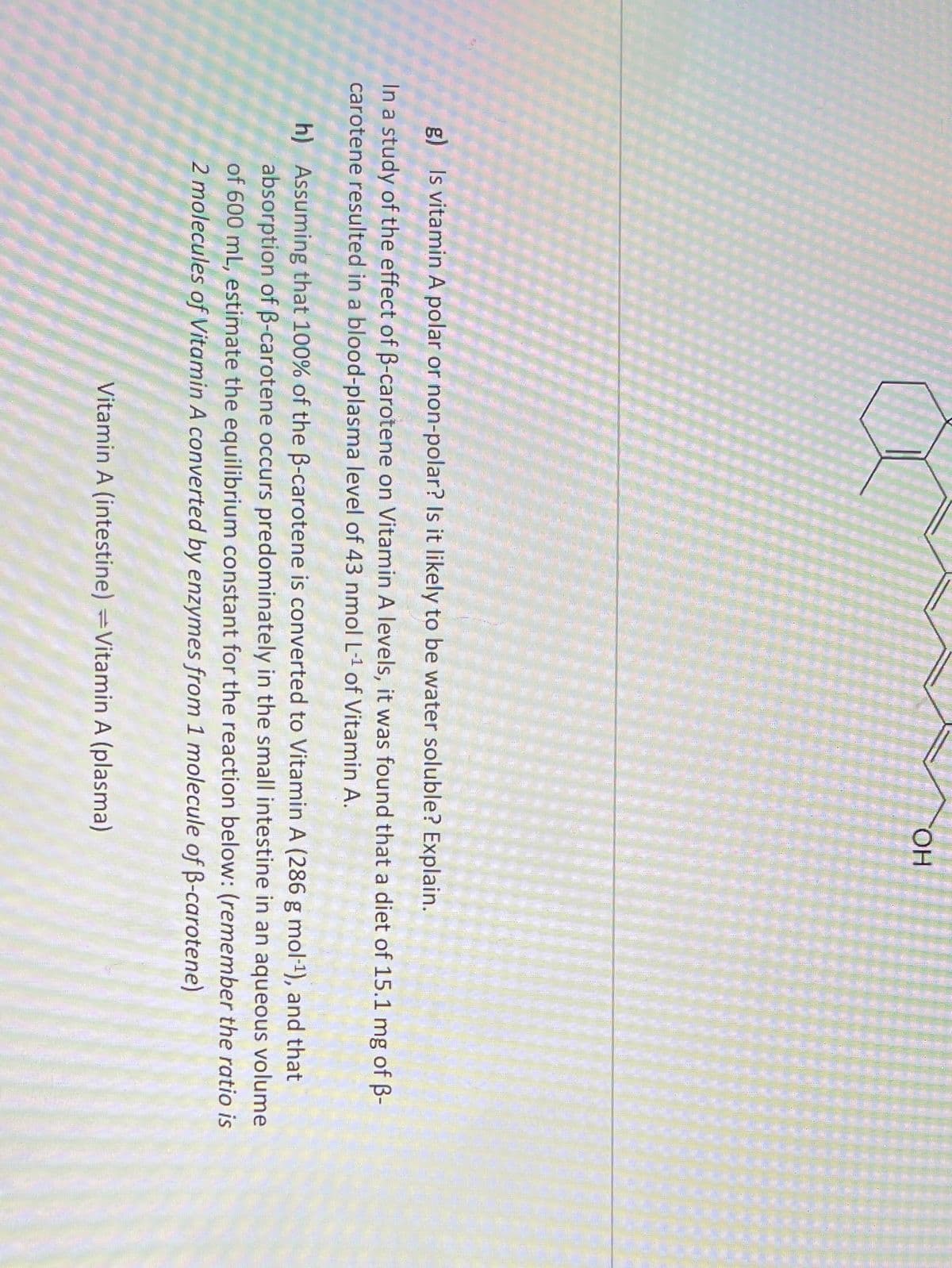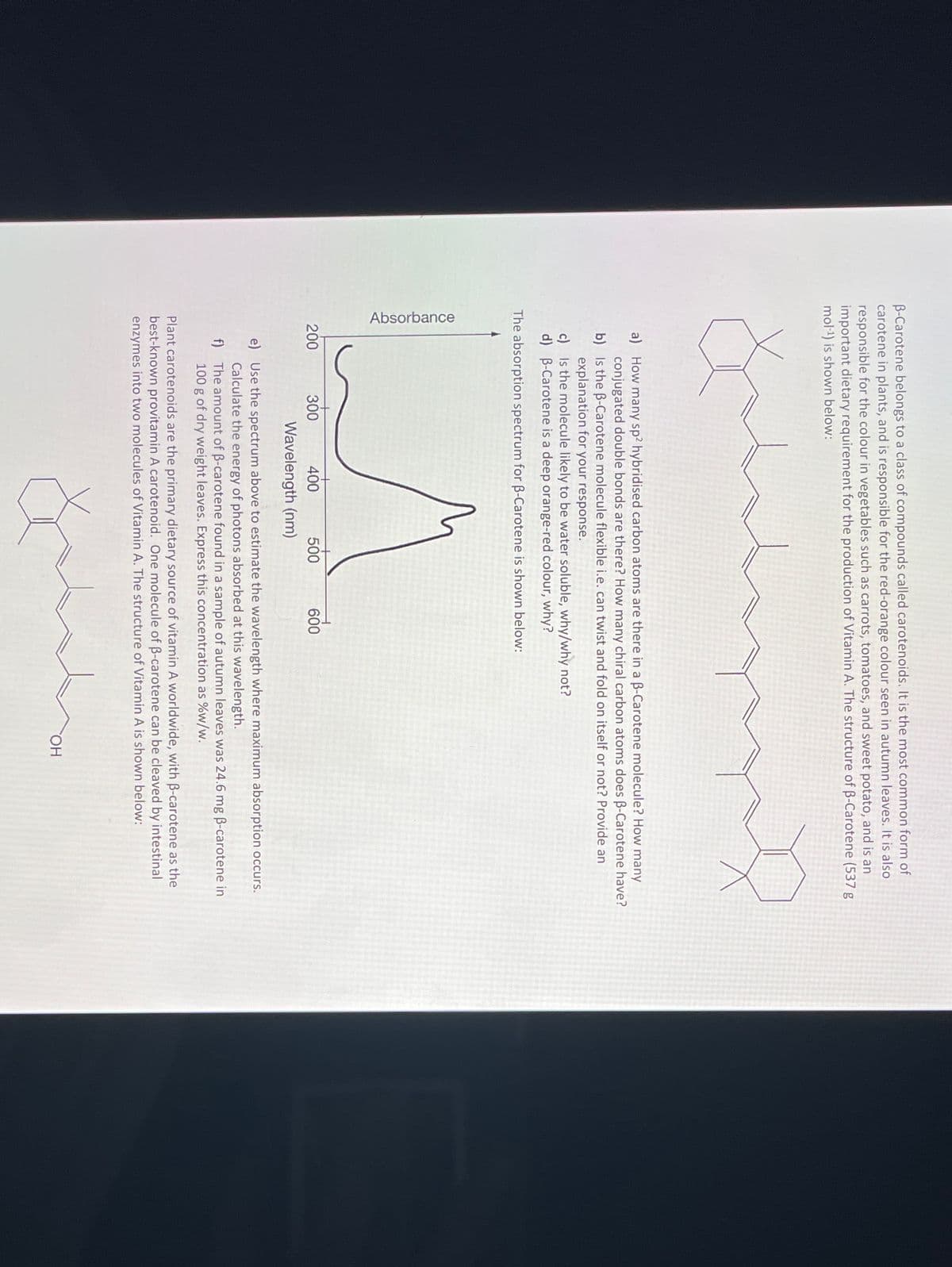B-Carotene belongs to a class of compounds called carotenoids. It is the most common form of carotene in plants, and is responsible for the red-orange colour seen in autumn leaves. It is also responsible for the colour in vegetables such as carrots, tomatoes, and sweet potato, and is an important dietary requirement for the production of Vitamin A. The structure of B-Carotene (537 g mol-1) is shown below: a) How many sp? hybridised carbon atoms are there in a B-Carotene molecule? How many conjugated double bonds are there? How many chiral carbon atoms does B-Carotene have? b) Is the B-Carotene molecule flexible i.e. can twist and fold on itself or not? Provide an explanation for your response.
B-Carotene belongs to a class of compounds called carotenoids. It is the most common form of carotene in plants, and is responsible for the red-orange colour seen in autumn leaves. It is also responsible for the colour in vegetables such as carrots, tomatoes, and sweet potato, and is an important dietary requirement for the production of Vitamin A. The structure of B-Carotene (537 g mol-1) is shown below: a) How many sp? hybridised carbon atoms are there in a B-Carotene molecule? How many conjugated double bonds are there? How many chiral carbon atoms does B-Carotene have? b) Is the B-Carotene molecule flexible i.e. can twist and fold on itself or not? Provide an explanation for your response.
Organic Chemistry
8th Edition
ISBN:9781305580350
Author:William H. Brown, Brent L. Iverson, Eric Anslyn, Christopher S. Foote
Publisher:William H. Brown, Brent L. Iverson, Eric Anslyn, Christopher S. Foote
Chapter5: Alkenes: Bonding, Nomenclature, And Properties
Section: Chapter Questions
Problem 5.31P
Related questions
Question

Transcribed Image Text:HO.
g) Is vitamin A polar or non-polar? Is it likely to be water soluble? Explain.
In a study of the effect of B-carotene on Vitamin A levels, it was found that a diet of 15.1 mg of B-
carotene resulted in a blood-plasma level of 43 nmol L-1 of Vitamin A.
h) Assuming that 100% of the B-carotene is converted to Vitamin A (286 g mol-1), and that
absorption of B-carotene occurs predominately in the small intestine in an aqueous volume
of 600 mL, estimate the equilibrium constant for the reaction below: (remember the ratio is
2 molecules of Vitamin A converted by enzymes from 1 molecule of B-carotene)
Vitamin A (intestine) =Vitamin A (plasma)

Transcribed Image Text:Absorbance
B-Carotene belongs to a class of compounds called carotenoids. It is the most common form of
carotene in plants, and is responsible for the red-orange colour seen in autumn leaves. It is also
responsible for the colour in vegetables such as carrots, tomatoes, and sweet potato, and is an
important dietary requirement for the production of Vitamin A. The structure of B-Carotene (537 g
mol-1) is shown below:
a) How many sp2 hybridised carbon atoms are there in a B-Carotene molecule? How many
conjugated double bonds are there? How many chiral carbon atoms does B-Carotene have?
b) Is the B-Carotene molecule flexible i.e.can twist and fold on itself or not? Provide an
explanation for your response.
c) Is the molecule likely to be water soluble, why/why not?
d) B-Carotene is a deep orange-red colour, why?
The absorption spectrum for B-Carotene is shown below:
200
300
400
500
600
Wavelength (nm)
e) Use the spectrum above to estimate the wavelength where maximum absorption occurs.
Calculate the energy of photons absorbed at this wavelength.
f) The amount of B-carotene found in a sample of autumn leaves was 24.6 mg B-carotene in
100 g of dry weight leaves. Express this concentration as %w/w.
Plant carotenoids are the primary dietary source of vitamin A worldwide, with B-carotene as the
best-known provitamin A carotenoid. One molecule of B-carotene can be cleaved by intestinal
enzymes into two molecules of Vitamin A. The structure of Vitamin A is shown below:
HO,
Expert Solution
This question has been solved!
Explore an expertly crafted, step-by-step solution for a thorough understanding of key concepts.
This is a popular solution!
Trending now
This is a popular solution!
Step by step
Solved in 2 steps

Knowledge Booster
Learn more about
Need a deep-dive on the concept behind this application? Look no further. Learn more about this topic, chemistry and related others by exploring similar questions and additional content below.Recommended textbooks for you

Organic Chemistry
Chemistry
ISBN:
9781305580350
Author:
William H. Brown, Brent L. Iverson, Eric Anslyn, Christopher S. Foote
Publisher:
Cengage Learning


Organic Chemistry
Chemistry
ISBN:
9781305580350
Author:
William H. Brown, Brent L. Iverson, Eric Anslyn, Christopher S. Foote
Publisher:
Cengage Learning
